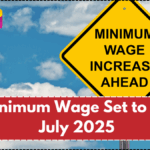Universal Credit sees another round of structural revisions aimed at refining how claimants interact with the system. The latest Universal Credit 2025 changes bring a sharper focus on employment incentives, particularly targeting low-income working households. These updates affect work allowances, taper rates, and eligibility thresholds—creating ripples across a large section of recipients.
The Department for Work and Pensions (DWP) claims the redesigned scheme is tailored to encourage employment without abruptly withdrawing financial support as people earn more. It aims to reduce the cliff-edge effect many workers previously experienced.

Updated Work Allowance Thresholds: Who Benefits Most?
One of the headline changes in the 2025 Universal Credit reform is the revised work allowance update. Work allowance refers to the amount a person can earn before their Universal Credit begins to reduce. For July 2025, these thresholds have increased:
| Household Type | Previous Work Allowance | New Work Allowance (July 2025) |
|---|---|---|
| With children or limited capability | £344 | £750 |
| Without children/limited capability | £0 | £200 |
This boost means claimants will retain more of their earnings before the taper kicks in. Working parents and those with limited work capacity stand to gain the most.
Income Taper Reforms: Earning More Without Losing More
The income taper reforms are another pivotal aspect of the 2025 changes. The taper rate, which determines how much Universal Credit is reduced as income rises, has been adjusted to a flat 50%. Previously set at 55%, the cut to 50% means individuals will lose 50p of Universal Credit for every £1 earned above their work allowance.
For example, a working parent earning £900 per month with a work allowance of £750 will only be subject to tapering on the £150 surplus. Under the new taper rate, they’d lose £75 in Universal Credit payments rather than £82.50 under the old rate. This subtle shift translates to more money staying in workers’ pockets.
Earning Limits and Adjusted Entitlements
Beyond allowances and taper rates, July 2025 also sees a re-evaluation of earnings limits tied to Universal Credit eligibility. Single earners with no children now face a ceiling of £19,500 annually for continued eligibility, while couples and families have a raised threshold of £33,000. This tweak aims to better reflect current living costs and inflation rates.
Additionally, self-employed claimants will now face monthly income reporting with a six-month grace period before the Minimum Income Floor is enforced. This change offers new businesses a more forgiving launch period, improving stability in early stages.
Targeted Support and Adjusted Requirements
The DWP is also rolling out tailored job support for those in part-time roles. If you’re working fewer than 20 hours weekly, you’ll now be required to attend mandatory progression interviews every 8 weeks. These sessions aim to help claimants increase hours or move to higher-paying roles.
Young claimants under 25 are now offered expanded access to training schemes tied to specific labor market shortages. This includes subsidized apprenticeships, especially in sectors like construction, logistics, and healthcare—part of the broader push to align Universal Credit policy with workforce demands.
Conclusion
The Universal Credit 2025 changes are part of a broader strategy to balance welfare support with economic participation. By lifting work allowances, revising income taper reforms, and modernizing earning thresholds, the government is signaling a firm shift toward incentivizing work without punishing income growth.
While the success of these reforms will depend on effective implementation and claimants’ ability to navigate the new rules, the intent is clear: provide more breathing room to those working on lower wages and create a smoother path out of welfare dependence.
FAQs
What is the new work allowance under Universal Credit 2025?
From July 2025, the work allowance for those with children or limited work capability has increased to £750. For those without, it is now £200.
How does the updated taper rate affect payments?
The taper rate is now 50%. This means for every £1 you earn above your work allowance, your Universal Credit is reduced by 50p instead of the previous 55p.
Who will benefit most from these Universal Credit 2025 changes?
Working families, especially single parents and those with health limitations, will benefit most due to higher work allowances and better income retention.
Are there changes to Universal Credit eligibility in 2025?
Yes. The income eligibility limit has increased to £19,500 for singles and £33,000 for families, aiming to include more low-income earners.
What happens if I work fewer than 20 hours a week?
You’ll be required to attend job progression interviews every 8 weeks to assess and support your journey toward higher income or more hours.
Click here to learn more
Aanchal is a skilled content writer with a flair for creating compelling and engaging stories. With a keen understanding of her audience, she crafts content that informs, inspires, and connects on a deeper level. From blog posts and articles to marketing copy, she brings both creativity and precision to every piece. Her expertise helps our brand communicate with clarity and leave a lasting impression.



